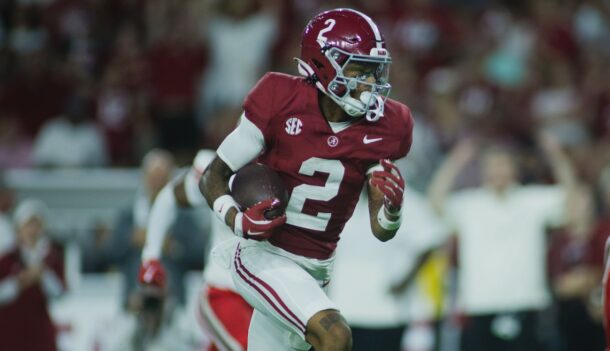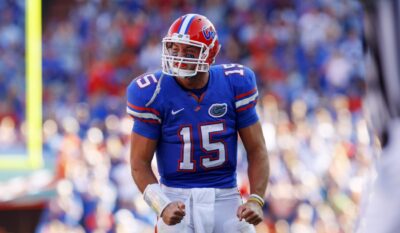
If Cincinnati (the real underdog) beats Alabama, it would be unlike any upset in college football history
Will Anderson has instincts beyond what any normal human being can comprehend. The Alabama star linebacker put together a season for the ages, and he’s 2 games from winning his second national title in as many years.
But when Anderson claimed that Alabama “was the underdog in this game,” well, he was mistaken. Greatly.
It’s not just that Alabama is nearly a 2-touchdown favorite. It’s who that nearly 2-touchdown underdog is. It’s Cincinnati, which everyone knows is already the first Group of 5 team to make the Playoff.
And if Cincinnati wins, it’d be unlike any upset we’ve ever seen in the sport.
Before you say “how could you not think about Boise State against Oklahoma?!” or “what about Stanford upsetting USC as a 41-point underdog in 2007?!” remember the context. Was a path to the national championship in play for both teams? Nope. Sorry, 2017 UCF, 2010 TCU, 2009 Boise State, 2008 Utah, 2006 Boise State and 2004 Utah. Going undefeated and winning a New Year’s 6 bowl game as a Group of 5 team was a remarkable feat. Fair or not, though, none of those games had a path to a national title.
Cincinnati has that path, albeit a narrow one. Just go out there and beat the defending champs, AKA the No. 1 team in the country that hasn’t lost to a non-Power 5 team since the Sugar Bowl at the end of the 2008 season. Oh, and in the 6 years since 247sports tracked talent composite, we’ve never seen a Playoff team outside the top 10 beat a team inside the top 10. Alabama is ranked No. 1 in that department and Cincinnati is ranked … No. 54.
Easy enough, right?
The weight of the Group of 5 world is on the broad shoulders of Cincinnati. But that’s not exactly the vibe the Bearcats are rolling with:
#Bearcats QB Desmond Ridder: “We’ve already had so much pressure on us throughout the entire season, marking off the checklist. Why add the pressure of every other non-Power 5 school onto our back? For us, it’s really just been about us, and will always continue to be about us.”
— Justin Williams (@Williams_Justin) December 27, 2021
Desmond Ridder doesn’t have to think about that. I, however, don’t mind going down that road.
Reality is there isn’t an exact comp for a potential Cincinnati upset. At least not in college football.
In the Playoff era, we’ve never seen a double-digit underdog win. Those teams are 0-6 with an average margin of defeat of 22.8 points. None of those games was decided by single digits, either. The biggest Playoff upset was the 2014 Sugar Bowl semifinal when Ohio State stunned Alabama as a 9.5-point underdog.
But a Cincinnati victory would go well beyond the 8-year window of the Playoff era. If we’re counting the Big East as a Power conference in the pre-Playoff era (we should) and we’re also including 20th century powerhouse independents (Miami, Notre Dame and Penn State) as Power 5 teams, we haven’t seen a non-Power 5 team play in an official national championship. Remember, that’s only been a thing since 1998.
The last time that a double-digit underdog won a Playoff game or a BCS National Championship was 2002 Ohio State, which stunned that loaded Miami team (thanks to a late pass interference call). The Buckeyes were 11-point dogs, though as highly regarded as the Hurricanes were, obviously Ohio State was a bit more established than modern-day Cincinnati.
The same was true when Oklahoma knocked off Florida State as a 10-point underdog in the BCS National Championship at the end of the 2000 season.
If you want to find a pre-BCS era example of a non-Power 5 conference team playing in a postseason game with national title hopes on the line, we’d have to go back to 1984 BYU. But even that was widely debated because the Cougars, who went undefeated and beat an unranked Michigan team in the Holiday Bowl, only faced 1 ranked foe all year. Washington, Nebraska and Florida had unclaimed national titles that season.
That’s a touch different from potentially beating the No. 1 team in the country and earning a national championship berth in the acknowledged Playoff system.
For the first time, the subjectivity associated with being a Group of 5 team is out the window. If the Bearcats win the next 2 games, they’ll be recognized as undisputed national champions by the NCAA. You’d have to go outside the sport to find a better comp.
In college basketball, we’ve seen plenty of mid-majors play for a national title. Shoot, look at all of these in the 21st century alone:
- 2021 Gonzaga (runner-up)
- 2018 Villanova (national champ)
- 2017 Gonzaga (runner-up)
- 2016 Villanova (national champ)
- 2014 UConn* (national champ)
- 2011 Butler (runner-up)
- 2010 Butler (runner-up)
- 2008 Memphis (runner-up)
*was member of AAC
Since 2010, it’s actually more common than not to have a “mid-major” playing in a national championship. At the same time, you’d be reaching to call modern-day Gonzaga or Villanova a mid-major, and 2014 UConn was a new member of the AAC after decades as a major conference member in the Big East. The power dynamics — and barriers to entry — are different in college hoops.
Not to do the whole “college basketball is a totally different playing field than college football” argument, but it’s true. There are more equalizers in college basketball than in college football (a 3-point shot, limited fouls, 5-on-5 instead of 11-on-11, etc.).
Butler taking on Duke in the 2010 NCAA Championship is probably the closest 21st century comp to Cincinnati-Alabama. Of course, Butler playing in its backyard in Indianapolis and nearly sinking the buzzer-beater of the century added to the lore of that matchup.
We don’t know if we’re about to get a made-for-Hollywood game in the Cotton Bowl. For all we know, Cincinnati will join the growing list of Playoff invitees who get blown out in the semifinal.
Perhaps a Cincinnati win would take on the feel of the classic 1985 NCAA Tournament title game in which Villanova stunned Patrick Ewing’s top-seeded Georgetown team. The 8-seed Wildcats went into the title game as 9-point underdogs against the defending national champs. But even that game involved 2 teams from the same conference that had already played twice in the regular season, so that’s not really a fair comp for Cincinnati-Alabama.
Friday’s showdown in Texas will be unique. The David vs. Goliath cliché is overused in sports. It should be reserved for contests of this magnitude.
Of course, Cincinnati would (and should) push back on any notion it’ll enter the postseason as a “David.” The Bearcats are 22-1 in the past 2 seasons, and they could have half a dozen players selected in the 2022 NFL Draft. Luke Fickell’s team finished the 2020 season as an AP Top 10 team, and it opened 2021 as an AP Top 10 team. Cincinnati isn’t satisfied with the history it already made just by reaching the Playoff.
As Ridder said, they aren’t worried about the historical enormity at stake. That’s fine. Anderson clearly wasn’t worried about the blowback to proclaiming that No. 1 seed, defending national champion and 2-touchdown favorite Alabama entered as the underdog.
But make no mistake about it — a Cincinnati upset would send shockwaves through the sport unlike any we’ve ever seen.
Connor O'Gara is the senior national columnist for Saturday Down South. He's a member of the Football Writers Association of America. After spending his entire life living in B1G country, he moved to the South in 2015.







